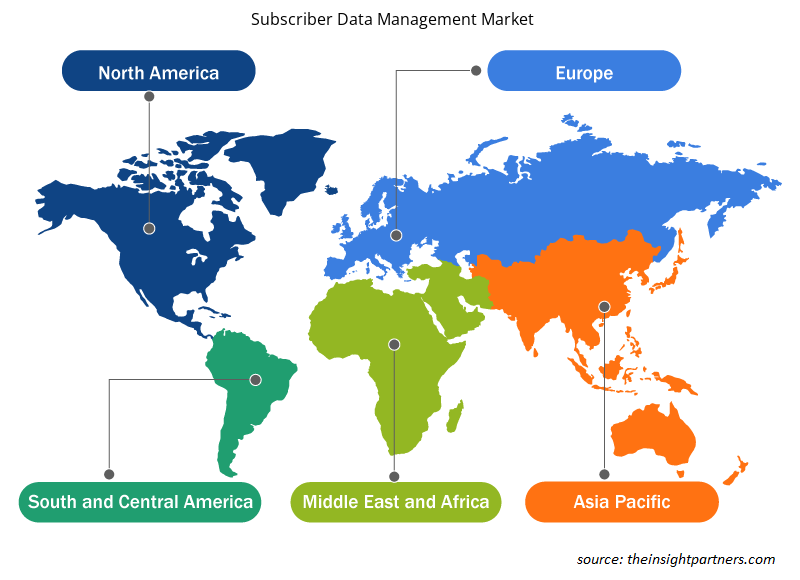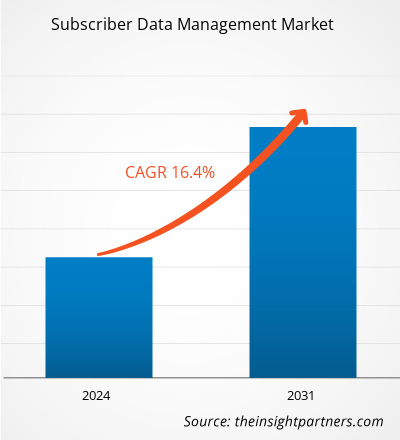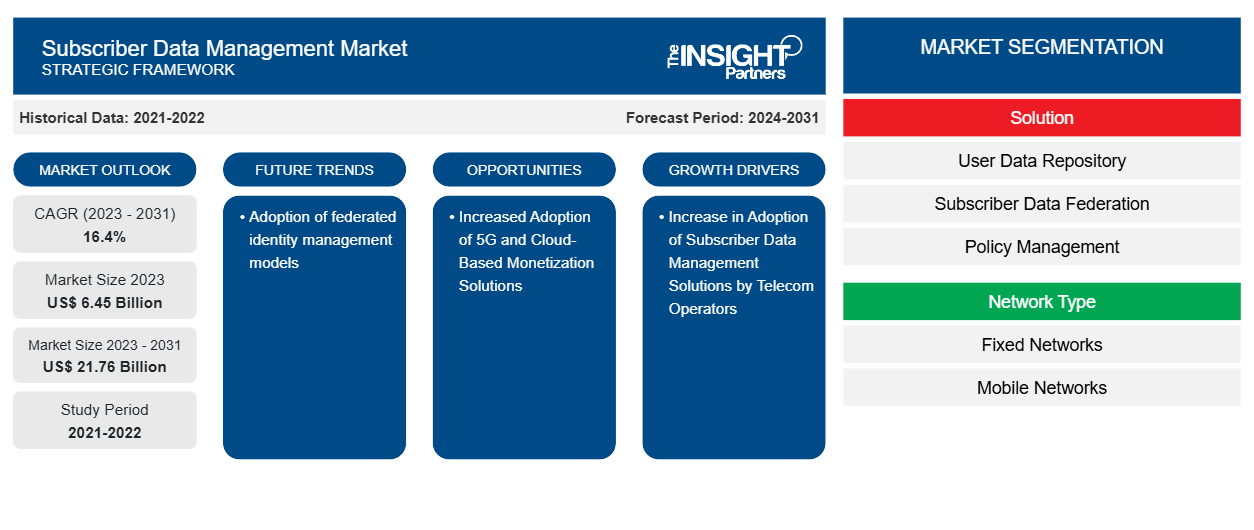가입자 데이터 관리 시장 규모는 2023년 64.5억 달러에서 2031년 217.6억 달러로 성장할 것으로 예상됩니다. 이 시장은 2023~2031년 동안 16.4%의 CAGR을 기록할 것으로 예상됩니다. 페더레이션 ID 관리 모델의 채택은 시장의 주요 트렌드로 남을 가능성이 높습니다.
가입자 데이터 관리 시장 분석
모바일 사용자 및 모바일 기기 수의 증가, 네트워크 기능 가상화(NFV)와 IP 시스템의 구축, LTE 및 VoLTE 기술에 대한 가입자 수요 증가가 모두 가입자 데이터 관리 수요를 견인하고 있습니다.
가입자 데이터 관리 시장 개요
가입자 데이터 관리(SDM)는 통신망이 단일 위치에서 소비자 데이터를 효율적으로 관리하는 방식을 말합니다. 업계의 데이터 관리 관행 은 가입자 위치, 네트워크(예: 2G/3G/5G) 및 기타 요인에 따라 별도의 저장소를 사용하는 것이었습니다. SDM은 모든 가입자 데이터를 통합하여 보다 효율적이고 안전한 사용자 데이터 관리를 제공하는 상식적인 솔루션입니다. SDM 솔루션은 액세스 환경 설정, 서비스, 위치, 인증, ID 및 존재를 포함하여 네트워크 사업자의 가입자 데이터를 통합하여 통합 데이터 저장소로 관리합니다. 또한 사용자에게 일관된 서비스를 유지하면서 운영 비용을 낮춰 통신망을 개선합니다. 또한 운영자가 가입자 데이터를 중앙에서 조사하여 가입자 데이터를 보다 효과적으로 수익화할 수 있도록 합니다. SDM은 또한 통신 사업자가 네트워크 복잡성, 총 소유 비용 및 새로운 서비스의 출시 시간을 낮추는 데 도움이 됩니다.
귀하의 요구 사항에 맞게 이 보고서를 사용자 정의하세요
이 보고서의 일부 또는 국가 수준 분석, Excel 데이터 팩을 포함하여 모든 보고서에 대한 사용자 정의를 무료로 받을 수 있으며 신생 기업 및 대학을 위한 훌륭한 혜택과 할인 혜택을 이용할 수 있습니다.
-
이 보고서의 주요 시장 동향을 알아보세요.이 무료 샘플에는 시장 동향부터 추정 및 예측까지 다양한 데이터 분석이 포함됩니다.
가입자 데이터 관리 시장 동인 및 기회
통신사 가입자 데이터 관리 솔루션 채택 증가로 시장 선호
가입자 데이터 관리(SDM) 솔루션은 다양한 네트워크 도메인에서 가입자 데이터 관리를 통합합니다. SDM 솔루션은 액세스 선호도, 서비스, 위치, 인증, ID 및 존재를 포함하여 네트워크 사업자의 가입자 데이터를 통합하여 관리하여 통합 데이터 저장소로 만듭니다. 또한 사용자에게 일관된 서비스를 유지하면서 운영 비용을 낮춰 통신사 네트워크를 개선합니다. 또한 운영자가 중앙 집중 방식으로 가입자 데이터를 검토하여 가입자 데이터를 보다 효과적으로 수익화할 수 있도록 합니다. SDM은 또한 통신 사업자가 네트워크 복잡성, 총 소유 비용 및 신규 서비스의 출시 시간을 낮추는 데 도움이 됩니다.
운영 비용을 낮추고 네트워크 간 융합을 용이하게 해야 할 필요성과 LTE 및 VoLTE에 대한 가입자 수요 증가, IMS 구현, 통신사의 NFV 기술로의 전환은 통신 기업 사이에서 가입자 데이터 관리 시장 성장을 촉진할 것입니다. 게다가 제3자는 통신 사업자가 느리지만 꾸준히 인정받는 새로운 가치 사슬을 제공함으로써 새롭고 개선된 서비스를 공급하도록 도울 수 있습니다. 통신 회사는 고객에게 유사한 수준의 개인화 및 활동 추적을 제공할 가능성을 모색하고 있습니다. 제3자는 통신 사업자의 인프라를 활용하여 제공할 수 있는 서비스를 개선하기 위해 가입자 데이터가 특히 매력적일 수 있습니다. 따라서 통신 사업자가 SDM 솔루션을 채택하는 것이 증가함에 따라 시장 성장이 크게 촉진되고 있습니다.
5G 및 클라우드 기반 수익화 솔루션 채택 증가
5G 기술과 클라우드 기반 수익화 솔루션의 채택이 증가함에 따라 가입자 데이터 관리 솔루션에 대한 수요가 증가하고 있습니다. 5G 기술을 통해 통신사는 실시간 소비자 데이터를 수집하고 정보에 입각한 결정을 내릴 수 있습니다. 분석 중심의 고객 가치 관리를 구현함으로써 통신사는 단 4주 만에 수익을 5~8%까지 늘릴 수 있습니다. 클라우드 기반 처리 및 저장의 급증과 소셜 미디어 및 고화질 주문형 비디오 콘텐츠의 확장으로 가입자 데이터 관리 솔루션에 대한 필요성이 커지고 있습니다. 5G 및 클라우드 기반 수익화 기술의 도입으로 주요 산업 참여자에게 잠재력이 창출됩니다. 통신사는 콘텐츠 제작자와 계약을 맺어 소수의 사용자에게 어필하는 5G 지원 경험을 수익화할 수 있습니다. 5G는 통신사에게 엔터테인먼트와 도박이라는 두 가지 중요한 상업적 기회를 제공합니다.
가입자 데이터 관리 시장 보고서 세분화 분석
가입자 데이터 관리 시장 분석에서 중요한 요소는 솔루션, 네트워크 유형, 배포, 애플리케이션입니다.
- 솔루션에 따라 시장은 사용자 데이터 저장소, 가입자 데이터 연합, 정책 관리 및 ID 관리로 세분화됩니다. 사용자 데이터 저장소 세그먼트는 2023년에 상당한 시장 점유율을 차지했습니다.
- 네트워크 유형에 따라 시장은 고정 네트워크와 모바일 네트워크로 세분화됩니다. 고정 네트워크 세그먼트는 2023년에 더 큰 시장 점유율을 차지했습니다.
- 배포를 기준으로 시장은 클라우드와 온프레미스로 세분화됩니다. 클라우드 세그먼트는 2023년에 시장에서 가장 큰 점유율을 차지했습니다.
- 애플리케이션 기준으로 시장은 음성 IP와 모바일로 세분화됩니다. 음성 IP 세그먼트는 2023년에 시장에서 가장 큰 점유율을 차지했습니다.
지역별 가입자 데이터 관리 시장 점유율 분석
가입자 데이터 관리 시장 보고서의 지리적 범위는 주로 북미, 아시아 태평양, 유럽, 중동 및 아프리카, 남미 및 중부 아메리카의 5개 지역으로 나뉩니다.
북미는 2023년 시장을 지배했습니다. GSM 협회의 보고서에 따르면, 운영자의 지속적인 네트워크 지출과 다양한 가격대의 5G 기기 선택 증가로 인해 북미는 2022년까지 1억 개의 5G 연결을 갖게 될 것입니다. 북미는 2025년까지 5G가 모든 연결의 절반 이상을 차지하는 첫 번째 지역이 될 것입니다. 결과적으로 5G 가입자 수가 증가함에 따라 네트워크 운영자는 고객의 모바일 요금제를 적절하게 관리하는 것을 우선시해야 하며, 이로 인해 가입자 데이터 관리에 대한 수요가 증가하게 됩니다. COVID-19 발병과 미국, 캐나다, 멕시코와 같은 국가에 부과된 후속 봉쇄로 인해 이 지역의 OTT 가입자 수가 크게 증가했습니다. 예를 들어, Comscore의 2020년 연구에 따르면 2020년 4월에 미국에서 6,980만 가구가 OTT를 사용했으며, 이는 전년 대비 520만 가구 증가한 수치입니다.
게다가, 팬데믹이 미국에 상당한 영향을 미치기 시작한 2020년 3월에는 음악 스트리밍이 3주 연속 하락했습니다. 처음에는 2%, 그다음에는 8.8%, 마지막으로 3.2% 하락했습니다. 하지만 미국에서 음악 스트리밍은 2020년 4월 2일로 끝나는 주에 2% 증가하기 시작했고, 그 추세는 지금까지 이어지고 있습니다. 따라서 다양한 플랫폼에서 가입자가 증가한 것은 팬데믹 기간 동안 이 지역 전체의 가입자 데이터 관리 시장에 긍정적인 영향을 미쳤습니다.
구독자 데이터 관리 시장 지역 통찰력
Insight Partners의 분석가들은 예측 기간 동안 가입자 데이터 관리 시장에 영향을 미치는 지역적 추세와 요인을 철저히 설명했습니다. 이 섹션에서는 북미, 유럽, 아시아 태평양, 중동 및 아프리카, 남미 및 중미의 가입자 데이터 관리 시장 세그먼트와 지리에 대해서도 설명합니다.

- 가입자 데이터 관리 시장을 위한 지역별 데이터 얻기
가입자 데이터 관리 시장 보고서 범위
| 보고서 속성 | 세부 |
|---|---|
| 2023년 시장 규모 | 64억 5천만 달러 |
| 2031년까지 시장 규모 | 217억 6천만 달러 |
| 글로벌 CAGR (2023-2031) | 16.4% |
| 역사적 데이터 | 2021-2022 |
| 예측 기간 | 2024-2031 |
| 다루는 세그먼트 |
솔루션별로
|
| 포함된 지역 및 국가 |
북아메리카
|
| 시장 선도 기업 및 주요 회사 프로필 |
|
구독자 데이터 관리 시장 참여자 밀도: 비즈니스 역학에 미치는 영향 이해
구독자 데이터 관리 시장은 소비자 선호도의 변화, 기술 발전, 제품의 이점에 대한 인식 증가와 같은 요인으로 인해 최종 사용자 수요가 증가함에 따라 빠르게 성장하고 있습니다. 수요가 증가함에 따라 기업은 제품을 확장하고, 소비자의 요구를 충족하기 위해 혁신하고, 새로운 트렌드를 활용하여 시장 성장을 더욱 촉진하고 있습니다.
시장 참여자 밀도는 특정 시장이나 산업 내에서 운영되는 회사나 기업의 분포를 말합니다. 주어진 시장 공간에 얼마나 많은 경쟁자(시장 참여자)가 존재하는지 그 규모나 총 시장 가치에 비해 나타냅니다.
가입자 데이터 관리 시장에서 운영되는 주요 회사는 다음과 같습니다.
- 시스코 시스템즈 주식회사
- 휴렛팩커드 엔터프라이즈 개발 LP
- 화웨이 테크놀로지스 주식회사
- 노키아 주식회사
- 오라클 주식회사
- 텔레포낙티볼라겟 LM Ericsson
면책 조항 : 위에 나열된 회사는 어떤 특별한 순서에 따라 순위가 매겨지지 않았습니다.

- 구독자 데이터 관리 시장의 주요 기업 개요를 알아보세요
구독자 데이터 관리 시장 뉴스 및 최근 개발
가입자 데이터 관리 시장은 1차 및 2차 조사 이후의 질적, 양적 데이터를 수집하여 평가합니다. 여기에는 중요한 기업 간행물, 협회 데이터, 데이터베이스가 포함됩니다. 가입자 데이터 관리 시장의 몇 가지 개발 사항은 다음과 같습니다.
- Cisco는 Socio Labs, Inc. 인수 완료를 발표했습니다. 이를 통해 회사는 WebEx 제공 범위를 회의, 웨비나, 웹캐스트를 넘어 컨퍼런스까지 확장하고 하이브리드 이벤트의 미래를 구축하고자 합니다. Socio Labs는 멀티 세션, 멀티 트랙 가상, 대면 및 하이브리드 컨퍼런스의 전체 라이프사이클을 관리하는 최신 이벤트 기술 플랫폼입니다. (출처: Cisco, 보도자료, 2021년 7월)
- Cisco는 Vodafone Idea Limited와 협력하여 4G 및 5G 사용 사례를 지원하기 위해 네트워크를 단순화하고 자동화했습니다. 또한 소비자, 소매 및 기업 고객에게 더 나은 품질의 경험을 제공합니다. 이를 위해 Vodafone Idea는 인도 전역에 Cisco의 Ultra Packet Core를 배포하여 디지털 변환을 가속화하고 있습니다. (출처: Cisco, 보도자료, 2021년 6월)
가입자 데이터 관리 시장 보고서 범위 및 제공물
"구독자 데이터 관리 시장 규모 및 예측(2021-2031)" 보고서는 아래 영역을 포괄하는 시장에 대한 자세한 분석을 제공합니다.
- 범위에 포함된 모든 주요 시장 세그먼트에 대한 글로벌, 지역 및 국가 수준의 가입자 데이터 관리 시장 규모 및 예측
- 가입자 데이터 관리 시장 동향 및 동인, 제약, 주요 기회와 같은 시장 역학
- 자세한 PEST/포터의 5가지 힘과 SWOT 분석
- 주요 시장 동향, 글로벌 및 지역 프레임워크, 주요 업체, 규정 및 최근 시장 개발 사항을 포괄하는 가입자 데이터 관리 시장 분석
- 시장 집중도, 히트맵 분석, 유명 업체 및 가입자 데이터 관리 시장의 최근 개발 사항을 다루는 산업 환경 및 경쟁 분석
- 자세한 회사 프로필
- 과거 분석(2년), 기준 연도, CAGR을 포함한 예측(7년)
- PEST 및 SWOT 분석
- 시장 규모 가치/거래량 - 글로벌, 지역, 국가
- 산업 및 경쟁 환경
- Excel 데이터세트
최근 보고서
관련 보고서
사용 후기
구매 이유
- 정보에 기반한 의사 결정
- 시장 역학 이해
- 경쟁 분석
- 고객 인사이트
- 시장 예측
- 위험 완화
- 전략 기획
- 투자 타당성 분석
- 신흥 시장 파악
- 마케팅 전략 강화
- 운영 효율성 향상
- 규제 동향에 발맞춰 대응























 무료 샘플 받기 - 가입자 데이터 관리 시장
무료 샘플 받기 - 가입자 데이터 관리 시장